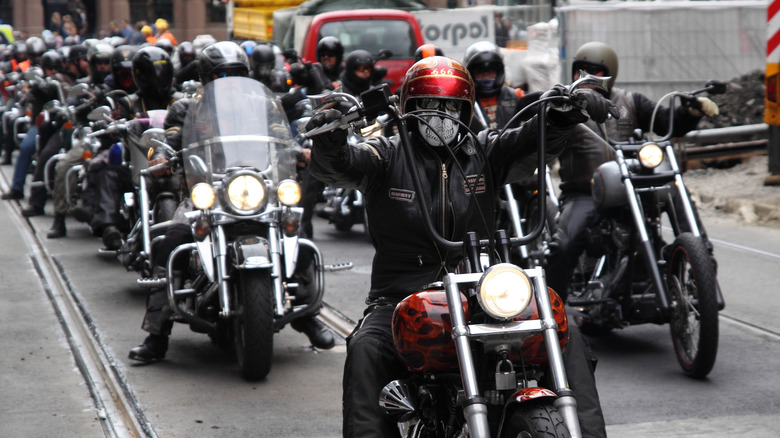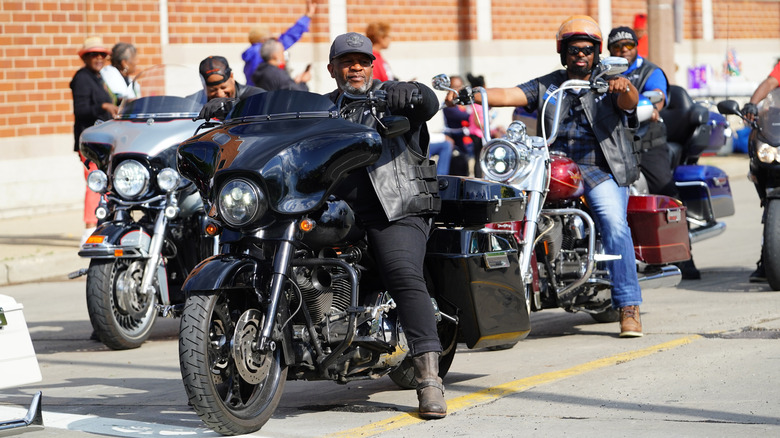What Is The Biggest Motorcycle Club In Texas And When Was It Founded?
In March 1966, a dockworker from Houston, Texas, named Donald Chambers recruited bikers from local bars to form an organization called the Bandidos Motorcycle Club — named after the Mexican bandits who lived in camaraderie despite being rebellious to the laws of the land. Determined to fully embrace the lifestyle of the outlaws, the then-36-year-old only chose members brave enough not to conform to the norms of society, but willing to join a movement that centered on traversing the scenic landscapes of the Lone Star State on Harley-Davidson motorcycles.
Most of the early Bandidos were war veterans who had fought in Vietnam and found solace in the brotherhood Chambers offered through the club and the thrill the biker lifestyle entailed. One of the organization's first members, Royce Showalter, told Texas Monthly, "Don wasn't looking for people who fit into what he called 'polite society.'" Instead, he was after those seeking the highs of being an outcast, promising prospects that there would be "no rules, no bull****, just the open road."
As Chambers' recruitment efforts spread across Texas, membership began to pick up. By the 1970s, the Bandidos reached over 100 people who had become easily recognizable through the club's signature tattoos and jackets with bottom rockers. Membership information became scarce in the years that followed until a supposedly peaceful meeting with the Cossacks, another biker club, turned bloody in May 2015; revealing that the Bandidos already had 1,100 members — making it one of, if not the biggest motorcycle club in Texas.
The rise of rivalries in the motorcycle club community
Tensions between different motorcycle clubs are not uncommon, especially among organizations of outlaw bikers. Such rebellious biker collectives have been referred to as "one percenters" — from a statement by the American Motorist Association distinguishing the 99% law-abiding motorcyclists from the 1% delinquents or outlaws. Long before the Bandidos came to be, the bikers' scene in Texas was dominated by another club — the Hells Angels, formed in 1948.
Showalter suggested that in order for the Bandidos to ascend to prominence, it had to gain notoriety by mirroring what the Hells Angels were doing. Chambers' club aggressively imbibed in freewheeling counterculture and often clashed with law enforcement to establish its reputation as the next big thing in Texas' gang-governed criminal landscape. Inadvertently, this led to a feud with the Hells Angels that culminated in a clubhouse attack, which killed two and injured 19 in 1996, according to Vice.
Since calling a truce, the Bandidos had gained the upper hand in the organized crime industry in Texas. As the dominating club, the Bandidos began collecting operational fees from other groups, including the Cossacks. When the Cossacks refused to pay and started wearing the Texas bottom rockers on their vests, the two clubs locked horns. At a supposedly peaceful gathering at a Twin Peaks restaurant in Waco in May 2015, the rival clubs had a deadly confrontation that left nine dead, 18 injured, and 177 arrested in one of the largest mass arrests in the country's history.
The Bandidos' grip over the Texas motorcycle gangs
Whether the Bandidos Motorcycle Club is the biggest in Texas is still up for debate. Texas Monthly claimed the group had at least 1,100 members in 2015, and half were based in Texas. On the other hand, The Washington Post reported 2,500 members in the same year, while more recent data presented in a study by ECPI University pegged it at 5,000 members. The total figure makes the Bandidos the second-largest outlaw motorcycle gang in the world, next only to Hells Angels, with over 6,000 members worldwide — though no estimates of its local members are available.
Surprisingly, even though the Bandidos' membership may seem to lag behind the Hells Angels, the group has defended its position at the top of the hierarchy of the Texas outlaw biker collectives. Authorities told the Austin American-Statesman that the club continues to reign the state's outlaw groups, asserting dominance and punishing those who dare to question their operations — like what happened to the Cossacks.
The aftermath of the 2015 altercation may have forced both the Bandidos and the Cossacks to scale back their criminal activities, this does not mean that the Bandidos no longer have its grip over the local bikers community. Members freely roam around on their hogs, executing money laundering schemes, drug and weapons trafficking, intimidation, prostitution, and even murder. Law enforcement agencies have time and again tried to contain the Bandidos and other outlaw clubs, but it's been an uphill battle.


